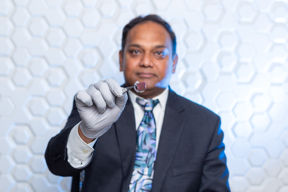Home > Press > Innovative silicon nanochip can reprogram biological tissue in living body
 |
| Chandan Sen
CREDIT Indiana University |
Abstract:
A silicon device that can change skin tissue into blood vessels and nerve cells has advanced from prototype to standardized fabrication, meaning it can now be made in a consistent, reproducible way. As reported in Nature Protocols, this work, developed by researchers at the Indiana University School of Medicine, takes the device one step closer to potential use as a treatment for people with a variety of health concerns.
Innovative silicon nanochip can reprogram biological tissue in living body
Bloomington, IN | Posted on December 10th, 2021
The technology, called tissue nanotransfection, is a non-invasive nanochip device that can reprogram tissue function by applying a harmless electric spark to deliver specific genes in a fraction of a second. In laboratory studies, the device successfully converted skin tissue into blood vessels to repair a badly injured leg. The technology is currently being used to reprogram tissue for different kinds of therapies, such as repairing brain damage caused by stroke or preventing and reversing nerve damage caused by diabetes.
“This report on how to exactly produce these tissue nanotransfection chips will enable other researchers to participate in this new development in regenerative medicine,” said Chandan Sen, director of the Indiana Center for Regenerative Medicine and Engineering, associate vice president for research and Distinguished Professor at the IU School of Medicine.
Sen also leads the regenerative medicine and engineering scientific pillar of the IU Precision Health Initiative and is lead author on the new publication.
Media kit: Access photos and video
“This small silicon chip enables nanotechnology that can change the function of living body parts,” he said. “For example, if someone’s blood vessels were damaged because of a traffic accident and they need blood supply, we can’t rely on the pre-existing blood vessel anymore because that is crushed, but we can convert the skin tissue into blood vessels and rescue the limb at risk.”
In the Nature Protocols report, researchers published engineering details about how the chip is manufactured.
Sen said this manufacturing information will lead to further development of the chip in hopes that it will someday be used clinically in many settings around the world.
“This is about the engineering and manufacturing of the chip,” he said. “The chip’s nanofabrication process typically takes five to six days and, with the help of this report, can be achieved by anyone skilled in the art.”
Sen said he hopes to seek FDA approval for the chip within a year. Once it receives FDA approval, the device could be used for clinical research in people, including patients in hospitals, health centers and emergency rooms, as well as in other emergency situations by first responders or the military.
Other study authors include Yi Xuan, Subhadip Ghatak, Andrew Clark, Zhigang Li, Savita Khanna, Dongmin Pak, Mangilal Agarwal and Sashwati Roy, all of IU, and Peter Duda of the University of Chicago.
This research is funded by the National Institutes of Health.
####
For more information, please click here
Contacts:
April Toler
Indiana University
Office: 618-319-0515
Copyright © Indiana University
If you have a comment, please Contact us.
Issuers of news releases, not 7th Wave, Inc. or Nanotechnology Now, are solely responsible for the accuracy of the content.
News and information
![]()
Resolving the puzzles of graphene superconductivity: Physicists publish a theoretical framework to explain the recent discovery of superconductivity in trilayer graphene December 10th, 2021
![]()
Development of a high-energy-resolution, LaB6 nanowire-based field emission gun: Electron source enables atomic resolution TEM observation December 10th, 2021
Govt.-Legislation/Regulation/Funding/Policy
![]()
Light speed advances: UD Prof. Tingyi Gu receives DARPA Young Faculty Award December 3rd, 2021
Possible Futures
![]()
Resolving the puzzles of graphene superconductivity: Physicists publish a theoretical framework to explain the recent discovery of superconductivity in trilayer graphene December 10th, 2021
![]()
Development of a high-energy-resolution, LaB6 nanowire-based field emission gun: Electron source enables atomic resolution TEM observation December 10th, 2021
![]()
DeepMind simulates matter on the nanoscale with AI December 10th, 2021
Chip Technology
![]()
Texas A&M chemist recognized for paving the way toward artificial intelligence and energy conversion December 10th, 2021
Nanomedicine
![]()
A new mechanism for generation of vesicles that transport molecules and vaccine nanoparticles into living cells December 10th, 2021
![]()
Scientists edge closer to probe that would inspect atherosclerotic plaques by forcing molecules to sound their presence December 3rd, 2021
Discoveries
![]()
Resolving the puzzles of graphene superconductivity: Physicists publish a theoretical framework to explain the recent discovery of superconductivity in trilayer graphene December 10th, 2021
![]()
Development of a high-energy-resolution, LaB6 nanowire-based field emission gun: Electron source enables atomic resolution TEM observation December 10th, 2021
![]()
DeepMind simulates matter on the nanoscale with AI December 10th, 2021
Announcements
![]()
Development of a high-energy-resolution, LaB6 nanowire-based field emission gun: Electron source enables atomic resolution TEM observation December 10th, 2021
![]()
DeepMind simulates matter on the nanoscale with AI December 10th, 2021
![]()
PASQAL announces quantum computing collaboration with NVIDIA December 10th, 2021
![]()
A new mechanism for generation of vesicles that transport molecules and vaccine nanoparticles into living cells December 10th, 2021
Interviews/Book Reviews/Essays/Reports/Podcasts/Journals/White papers/Posters
![]()
Resolving the puzzles of graphene superconductivity: Physicists publish a theoretical framework to explain the recent discovery of superconductivity in trilayer graphene December 10th, 2021
![]()
DeepMind simulates matter on the nanoscale with AI December 10th, 2021
![]()
A new mechanism for generation of vesicles that transport molecules and vaccine nanoparticles into living cells December 10th, 2021
Nanobiotechnology
![]()
A new mechanism for generation of vesicles that transport molecules and vaccine nanoparticles into living cells December 10th, 2021
![]()
Scientists edge closer to probe that would inspect atherosclerotic plaques by forcing molecules to sound their presence December 3rd, 2021
Research partnerships
![]()
PASQAL announces quantum computing collaboration with NVIDIA December 10th, 2021
![]()
Scientists develop promising vaccine method against recurrent UTI November 19th, 2021










